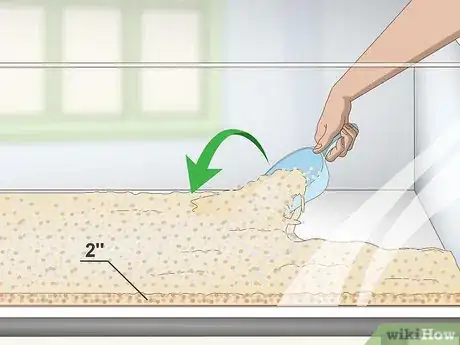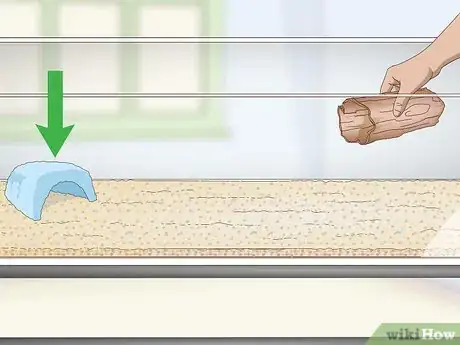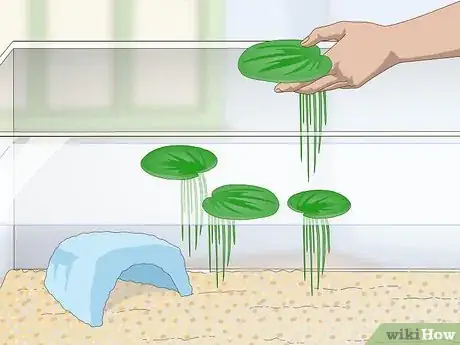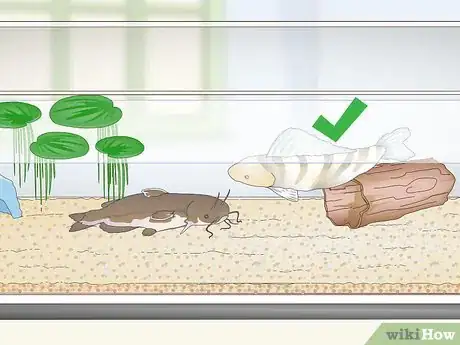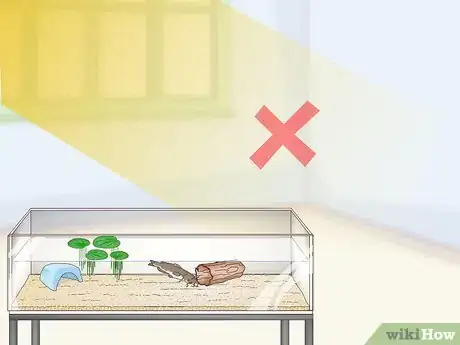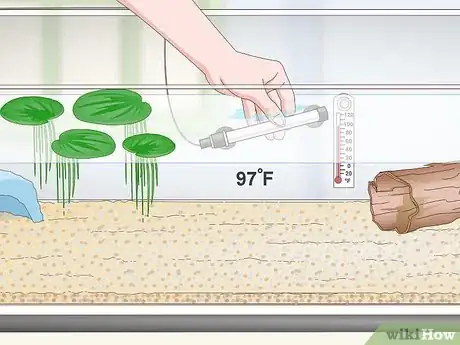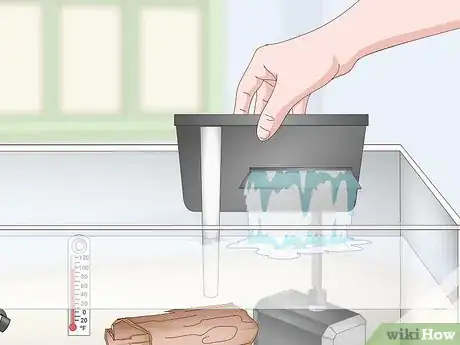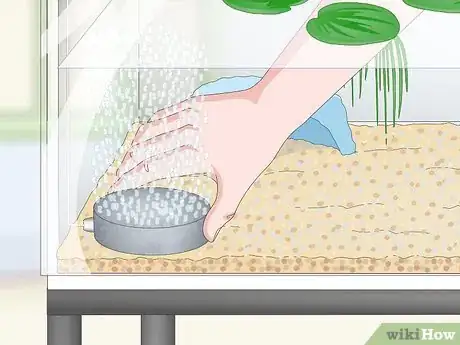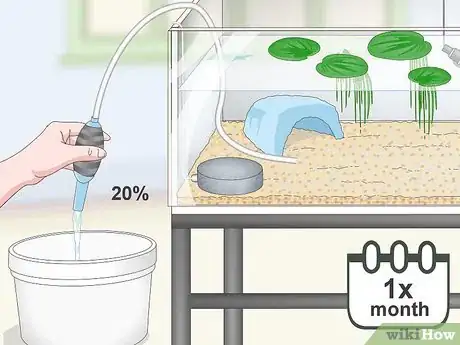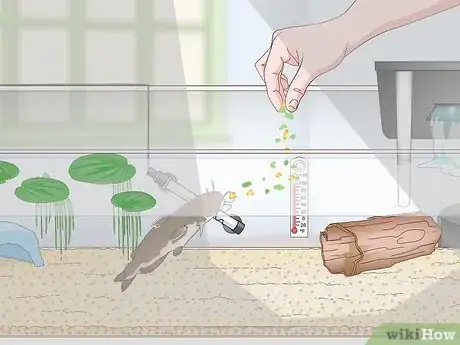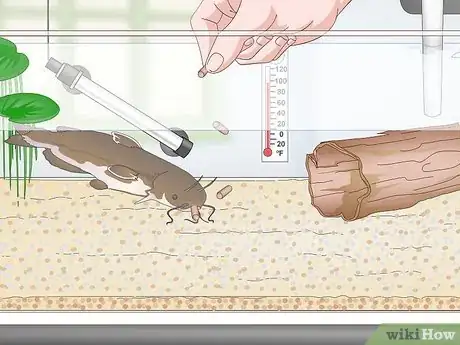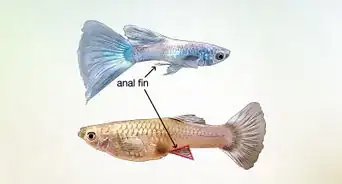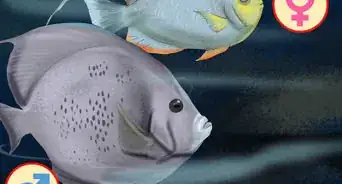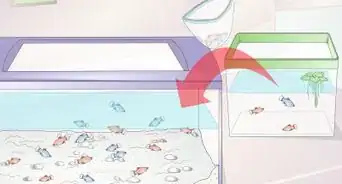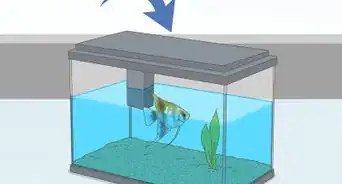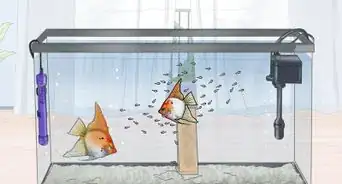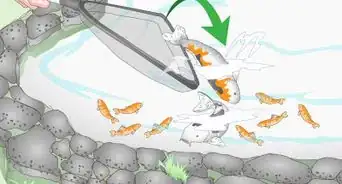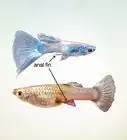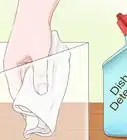This article was co-authored by Doug Ludemann. Doug Ludemann is the owner and operator of Fish Geeks, LLC, an aquarium services company based in Minneapolis, Minnesota. Doug has worked in the aquarium and fish-care industry for over 20 years, including having worked as a professional aquarist for the Minnesota Zoo and Shedd Aquarium in Chicago. He received his Bachelor of Science in Ecology, Evolution, and Behavior from the University of Minnesota.
There are 12 references cited in this article, which can be found at the bottom of the page.
wikiHow marks an article as reader-approved once it receives enough positive feedback. In this case, 87% of readers who voted found the article helpful, earning it our reader-approved status.
This article has been viewed 116,350 times.
Bullheads are an attractive breed of catfish that have interesting personalities to keep you entertained for hours. These fun pets can live up to 15 years and are easy to look after. Choose a large aquarium and fill it with plenty of floating plants and decorations. This gives the fish room to swim around and lots of places to hide. Monitor the oxygen, temperature, and pH level of the tank to maintain high water quality. Keep your catfish well nourished with small pieces of fruit and vegetables, and fish pellets. Enjoy watching your bullhead catfish thrive in its new home!
Steps
Setting up an Aquarium
-
1Choose a 100 gallon (378 L) tank to give the fish room to swim around. Bullhead catfish normally grow to about 12 inches (30 cm) long. A 100 gallon (378 L) tank gives the catfish enough room to freely move around and allows it to get plenty of exercise.[1]
- This size tank is appropriate for up to 3 fish. If you have more fish, you will need to get a larger tank. If you have 5 fish, opt for a 200 gallon (756 L) tank.
- Purchase a tank from a fish shop or search online for a secondhand one.
-
2Put 2 inches (5.1 cm) of gravel in the bottom of the tank. This substrate gives plants something to place their roots into and allows the catfish to dig into the gravel to search for flakes of food. Spread the gravel evenly across the tank to provide a base for the plants and decorations in the tank.[2]
- Purchase gravel from a pet shop or source your own from outside.
- Rinse the gravel under water before you place it into the tank.
- Avoid using sand as a substrate because this causes the tank to get cloudy and dirty.
EXPERT TIPUse a substrate that's not very abrasive, because the catfish are going to stay on the bottom of the tank a lot.
Doug Ludemann is the owner and operator of Fish Geeks, LLC, an aquarium services company based in Minneapolis, Minnesota. Doug has worked in the aquarium and fish-care industry for over 20 years, including having worked as a professional aquarist for the Minnesota Zoo and Shedd Aquarium in Chicago. He received his Bachelor of Science in Ecology, Evolution, and Behavior from the University of Minnesota.
Doug Ludemann
Professional Aquarist Doug Ludemann
Doug Ludemann
Professional AquaristAdvertisement -
3Add driftwood and caves to the tank to give the fish somewhere to hide. Catfish enjoy having cover from light during the day. Tank decorations are a great way to provide shelter for the catfish and help the tank to look nice. Spread the decorations around the tank to allow the catfish room to swim around the obstacles. Push the decorations into the gravel to keep them stable in the tank.[3]
- Castles and large fish tank toys also work well in a catfish aquarium.
- Rinse driftwood under water before placing it in the tank.
-
4Fill the tank to the half-way mark with unchlorinated water. Chlorine can negatively affect the health of your catfish. Use unchlorinated water to keep the fish at optimum health. If your tap water is unchlorinated, use this to fill the tank. If your tap water is not suitable, purchase unchlorinated water online or from a pet shop.[4]
- Only filling the tank halfway prevents the fish from jumping out of the tank and means that you don't need to use a lid.
- If you don't have unchlorinated water, consider using a dechlorinating agent to neutralise the chlorine in the water.
-
5Add floating plants to the tank to give the fish cover and oxygen. Bullhead catfish are nocturnal and often like to hide from light during the day. Choose aquarium plants that float on the top of the water and provide shade.
- Duckweed, Water lettuce, Hornwort, and Salvina are great floating plants.
- Purchase floating plants from a pet shop or an aquarium plant grower.
- Follow the planting instructions that come with each plant.
-
6Choose tank companions that are larger than the catfish. Bullhead catfish will try to eat any fish that will fit in its mouth. Opt for fish that are at least the same size as the catfish.[5]
- Bullhead catfish are happy to live by themselves in a tank — making companions an optional addition to the tank.
- Large sunfish, perch, and cyprinids make good tank companions for bullhead catfish.
-
7Place the tank in an area out of direct sunlight. Catfish are nocturnal, so they don't like intense sun exposure. If possible, place the tank in a dim hallway or room. If your tank is beside a window, close the curtains during the day to block the direct light.[6]
- If you can't place your tank in a dim area, cover the tank with a dark cloth during the brightest times of the day.
Maintaining Water Quality and Temperature
-
1Use a tank heater to keep the water temperature under 36 °C (97 °F). Bullhead catfish are really adaptable to different water temperatures. If you have other fish in your tank, keep the water around 26 °C (79 °F). If the bullhead catfish is the only fish in the tank, keep the water between 26 °C (79 °F) and 36 °C (97 °F).[7]
- Purchase a tank heater online or from a pet shop.
- Attach the tank heater on the side of the tank near the surface of the water and then select the appropriate temperature on the heating dial.
- Water temperatures over 37 °C (99 °F) can be fatal to bullhead catfish.
EXPERT TIPDoug Ludemann is the owner and operator of Fish Geeks, LLC, an aquarium services company based in Minneapolis, Minnesota. Doug has worked in the aquarium and fish-care industry for over 20 years, including having worked as a professional aquarist for the Minnesota Zoo and Shedd Aquarium in Chicago. He received his Bachelor of Science in Ecology, Evolution, and Behavior from the University of Minnesota.Professional Aquarist
 Doug Ludemann
Doug Ludemann
Professional AquaristReplicate the temperature bullhead catfish are used to. Bullhead catfish come from northern temperature ranges, so they won't do well in a constant tropical environment. Ideally, you would cool them in the winter and warm them in the summer, mimicking a cyclical change.
-
2Install a mechanical filter system that processes 150 gal (567 L) of water per hour. This filter system is appropriate for a 50-gal (189-L) tank, as the water in the catfish tank needs to be filtered 3 times per hour. If you have a larger tank, you will need a more powerful filter system.[8]
- Place the filter system next to the tank heater. Follow the instructions on the packet, as each filter system has a different setup process.
-
3Select an aeration system that oxygenates your tank to 4 mg (0.00014 oz) per 1 L (0.26 US gal). Fish can become stressed if there is too much or too little oxygen in the water. To set the oxygen level, simply turn the dial on the aeration system or follow the specific instructions from your system.[9]
- If you don't already have an aeration system, purchase one from a pet shop. Check your existing filter system for an aeration system, as many filters come with oxygenators.
- Place the oxygenator tube along the bottom of the fish tank and place the dial beside the tank.
-
4Keep the water pH between 3.4 and 7.0 using shells and driftwood. Bullhead catfish are extremely resilient and can withstand a range of pH levels. Use pH test kit to find out the pH of the water each day. If the water has a low pH, add a handful of seashells to the water. If the aquarium has a high pH, place a piece of driftwood into the tank.[10]
- Continue to add and remove shells and driftwood to naturally balance the pH level of the water.
-
5Replace 20% of the water once a month to keep the tank clean. If the water is left to sit in the tank for too long, the tank will get dirty. If you have a 50 gallon (189 L) tank, replace 10 gallons (18.9 L) of water each month. Use a bucket to remove water or use a syphon.[11]
- Replace the old water with unchlorinated water.
- Dispose of the old water in the garden or down the drain.
Feeding Your Catfish
-
1Feed the catfish in the evenings. Catfish are nocturnal, so they tend to wake up in the late afternoon or early evening. Place the food in the tank before you go to bed to ensure that the catfish are awake when you feed them.[12]
-
2Give your catfish 1 pinch of catfish fish pellets each day for nutrition. This helps to ensure that your bullhead catfish receives enough protein and vitamins. Any flakes or pellets designed for fish will work well for catfish. Follow the feeding instructions on the back of the packet.[13]EXPERT TIPDoug Ludemann is the owner and operator of Fish Geeks, LLC, an aquarium services company based in Minneapolis, Minnesota. Doug has worked in the aquarium and fish-care industry for over 20 years, including having worked as a professional aquarist for the Minnesota Zoo and Shedd Aquarium in Chicago. He received his Bachelor of Science in Ecology, Evolution, and Behavior from the University of Minnesota.Professional Aquarist

 Doug Ludemann
Doug Ludemann
Professional AquaristNot sure what to feed your catfish? According to professional aquarist Doug Ludemann: "Just like any other catfish, bullhead catfish are going to eat off the bottom of the tank, so give them a sinking pellet. There are even specialty catfish pellets you can use. In addition to their pellets, give them a variety of meaty foods like earthworms, krill, and silversides."
-
3Feed your catfish up to 1 handful of leftover fruit and vegetables each day. Bullhead catfish are scavengers and enjoy a varied diet. Chop the fresh fruit and vegetables into 0.75 in (1.9 cm) cubes, so that they will fit into catfish's mouth. Drop the produce into the tank and wait for the fish to search it out in the bottom of the tank.[14]
- Feed the fish a maximum of ½ cup (~25 g) of produce each day. If the fish stop eating the food, this shows that they are full.
- Bullhead catfish thrive off organic produce and fish pellets because they don't contain any pesticides. Look for products that are spray-free or organically grown to help the fish reach optimum health.
Community Q&A
-
QuestionI just got a new Bullhead. It is only about half an inch long and I don't know what would be small enough to feed it. Help?
 Community AnswerAnything will do, from cut up bits of corn to bits of worm. Spam will also work, but as long as the food you use to feed it is something that can sink to the bottom, they are likely to enjoy it.
Community AnswerAnything will do, from cut up bits of corn to bits of worm. Spam will also work, but as long as the food you use to feed it is something that can sink to the bottom, they are likely to enjoy it. -
QuestionWhat do I feed a black bullhead catfish?
 Community AnswerBullhead are not picky eaters at all and will eat a lot of different foods ranging from live food to dead food. You should try it all. Start with bloodworms and feeder fish.
Community AnswerBullhead are not picky eaters at all and will eat a lot of different foods ranging from live food to dead food. You should try it all. Start with bloodworms and feeder fish. -
QuestionCan I keep a catfish in an aquarium at home?
 Community AnswerThat depends on the size of your catfish, as well as the size of your aquarium. In most cases, you should be able to.
Community AnswerThat depends on the size of your catfish, as well as the size of your aquarium. In most cases, you should be able to.
References
- ↑ https://youtu.be/qGk_17-Tj-s?t=4
- ↑ https://www.aquariumcarebasics.com/freshwater-aquarium-fish/cory-catfish/
- ↑ https://youtu.be/Sv0lIyx5XiM?t=400
- ↑ https://animals.mom.me/treat-fish-suffering-chlorine-poison-9338.html
- ↑ https://youtu.be/Sv0lIyx5XiM?t=400
- ↑ https://youtu.be/BdkgjBhHhpo?t=26
- ↑ https://www.cabi.org/isc/datasheet/94468
- ↑ https://www.planetcatfish.com/shanesworld/shanesworld.php?article_id=271
- ↑ https://thefishsite.com/articles/water-quality-monitoring-and-management-for-catfish-ponds
About This Article
To keep a bullhead catfish, keep it in a tank that holds at least 100 gallons of water. Line the bottom of the tank with gravel, and add driftwood, caves, and floating plants so your catfish has places to hide. If you want to add other fish to the tank, make sure they're the same size or bigger than your catfish or else it might try to eat them. To feed your bullhead catfish, give it 1 pinch of catfish pellets every evening, as well as a handful of leftover fruits and vegetables. To learn how to maintain the right water conditions for your catfish, scroll down!

